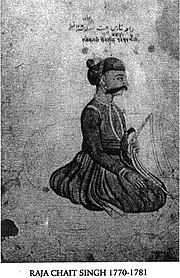This article may need to be rewritten to comply with Wikipedia's quality standards. (March 2024) |
State of Benares Banārasa rājya | |||||||||||||
|---|---|---|---|---|---|---|---|---|---|---|---|---|---|
| 1740–1948 | |||||||||||||
 Benares State (in red) in India 1940 (in green) | |||||||||||||
 Benares State in the Imperial Gazetteer of India | |||||||||||||
| Capital | Benares (Kashi) | ||||||||||||
| Common languages | Bhojpuri, Hindi-Urdu, English | ||||||||||||
| Religion | Hinduism (official), Islam, Jainism, Buddhism, Christianity | ||||||||||||
| Raja | |||||||||||||
• 1740 – 1770 (first) | Balwant Singh | ||||||||||||
• 1939 – 1947 (last) | Vibhuti Narayan Singh | ||||||||||||
| History | |||||||||||||
• Established | 1740 | ||||||||||||
| 1948 | |||||||||||||
| |||||||||||||
| Today part of | Varanasi and Chakia in Uttar Pradesh, India | ||||||||||||



Banaras State, initially known as Banaras kingdom or Kashi Kingdom, was a kingdom and later princely state under the Narayan Dynasty[1][2] in what is today Uttar Pradesh, India.
The state was founded by the Gautam Bhumihar Brahmin zamindar, Balwant Singh, who assumed the title of "Raja of Benares" in mid 18th century, taking advantage of the Mughal Empire's disintegration.[3][4] His descendants ruled the area around Benares after liberation from Awadh and later as feudatories of East India Company. In 1910, Benares became a full-fledged state of India.[5] The state was merged in India after India's independence in 1947, but even today the Kashi Naresh (the titular ruler) is highly respected by the people of Varanasi.[6] The Ruler of Benaras was the state's religious head and the people of Benares considered him to have been ordained the throne of Kashi by Lord Shiva (making him Kashi Naresh by proxy). He was also the chief cultural patron and an essential part of all religious celebrations. In 1948, the 88th ruler of Kashi Sir Vibhuti Narayan Singh accepted the request of the first Indian Prime minister Jawaharlal Nehru and signed the accession to the Indian Union.[7]
- ^ Sharma, Anurag (2022). Brahmins who refused to beg: brief history of Bhumihars, Ayachak Brahmins of East India. Chennai: Notion Press. ISBN 979-8-88833-370-9.
- ^ United Provinces of Agra and Oudh (India). "Benares State". Government Gazette.
- ^ Cite error: The named reference
CABayly1988was invoked but never defined (see the help page). - ^ Lethbridge, Roper (1893). The golden book of India, a genealogical and biographical dictionary of the ruling princes, chiefs, nobles, and other personages, titled or decorated, of the Indian empire. Robarts - University of Toronto. London Macmillan. p. 66.
- ^ Swati Mitra 2002, pp. 124–126.
- ^ Callewaert, Winand M.; Schilder, Robert (2000). Banaras: vision of a living ancient tradition. New Delhi: Hemkunt Publishers. ISBN 978-81-7010-302-8.
- ^ "Benares Princely State". Archived from the original on 8 June 2017. Retrieved 18 June 2014.

